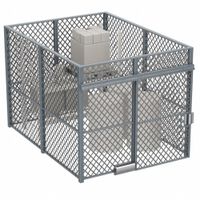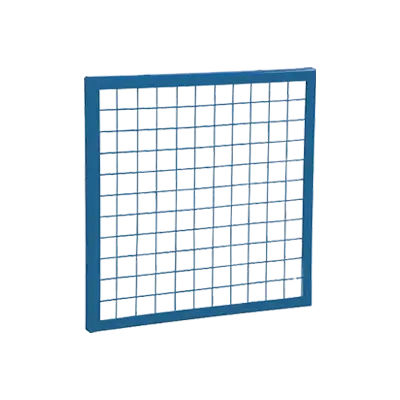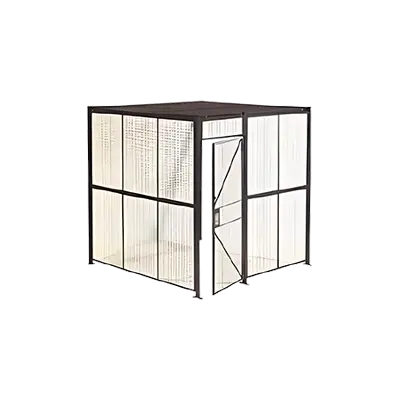Call +(254) 703 030 000 / 751 483 999 / 721 704 777
- Home
- Material Handling
- Storage Workspace
- Partitions Machine Guards
- Wire Partitions Cages
.....Read More
Frequently Asked Questions
What are the benefits of using wire partitions and security cages?
Wire partitions and security cages offer several benefits:
1. **Enhanced Security**: They provide a physical barrier that deters unauthorized access, protecting valuable assets, inventory, and sensitive information.
2. **Visibility**: The open design allows for clear visibility, enabling easy monitoring of contents without compromising security.
3. **Ventilation**: The mesh structure ensures proper airflow, preventing moisture buildup and maintaining optimal conditions for stored items.
4. **Flexibility**: Wire partitions can be customized and reconfigured to fit various spaces and needs, making them adaptable for different environments.
5. **Cost-Effective**: They are generally more affordable than solid walls or other security solutions, offering a budget-friendly option for enhancing security.
6. **Durability**: Made from robust materials like steel, they are resistant to damage and wear, ensuring long-term use.
7. **Quick Installation**: Wire partitions are relatively easy and quick to install, minimizing downtime and disruption to operations.
8. **Compliance**: They can help meet regulatory requirements for secure storage of certain items, such as pharmaceuticals or firearms.
9. **Space Optimization**: By creating secure zones within larger areas, they help in efficient space utilization without the need for permanent walls.
10. **Access Control**: They can be equipped with locks and other access control systems to manage entry and exit, enhancing security protocols.
11. **Aesthetic Appeal**: Available in various finishes and designs, they can complement the existing decor while providing security.
12. **Reduced Theft and Pilferage**: By restricting access and increasing visibility, they help in reducing theft and pilferage incidents.
13. **Safety**: They can be used to segregate hazardous materials, ensuring safety for personnel and compliance with safety regulations.
How do wire partitions and security cages enhance security in a facility?
Wire partitions and security cages enhance facility security by providing physical barriers that control access and protect valuable assets. These structures are made from durable materials like steel mesh, offering visibility while preventing unauthorized entry. They can be customized to fit specific areas, creating secure zones within a facility.
Wire partitions are often used to separate sensitive areas, such as inventory storage, server rooms, or hazardous material sections. By restricting access to these areas, they reduce the risk of theft, vandalism, and unauthorized access. Security cages can be equipped with locks and integrated with access control systems, ensuring that only authorized personnel can enter.
The open design of wire partitions allows for easy monitoring and surveillance, as security personnel can see through the mesh. This visibility acts as a deterrent to potential intruders, as they are aware they can be observed. Additionally, the partitions can be configured to include ceilings, further enhancing security by preventing overhead access.
Wire partitions and security cages are also flexible and modular, allowing for easy reconfiguration as security needs change. They can be quickly installed or relocated, providing a cost-effective solution for dynamic environments. Their robust construction ensures long-term durability, reducing maintenance costs and enhancing overall security infrastructure.
In summary, wire partitions and security cages enhance facility security by providing controlled access, deterring unauthorized entry, and allowing for effective monitoring. Their flexibility and durability make them a practical choice for safeguarding valuable assets and sensitive areas within a facility.
What materials are used in the construction of wire partitions and security cages?
Wire partitions and security cages are typically constructed using the following materials:
1. **Steel Wire Mesh**: The primary material used for the panels, offering strength and visibility. It is often galvanized or powder-coated to prevent rust and corrosion.
2. **Steel Frames**: These provide structural support to the wire mesh. They are usually made from tubular or angle iron steel, which is also galvanized or powder-coated for durability.
3. **Posts and Supports**: Made from steel, these components anchor the partitions and cages to the floor and ceiling, ensuring stability. They are often bolted or welded into place.
4. **Hinges and Locks**: Heavy-duty steel hinges and locks are used for doors and access points, providing security and ease of use. These components are often tamper-proof and may include padlocks or electronic locking systems.
5. **Fasteners and Hardware**: Bolts, nuts, and screws, typically made from stainless steel or zinc-coated steel, are used to assemble the partitions and cages, ensuring a secure fit.
6. **Panels and Doors**: Besides wire mesh, solid steel panels may be used for added security or privacy. Doors are often reinforced with additional steel bars or plates.
7. **Finish Coatings**: Powder coating or paint is applied to all steel components to enhance appearance and provide additional protection against environmental factors.
8. **Optional Materials**: For specific applications, materials like polycarbonate or acrylic panels may be used in conjunction with wire mesh for added visibility or protection against tampering.
These materials are chosen for their durability, security, and ability to withstand various environmental conditions, making them ideal for industrial, commercial, and institutional applications.
How do you install wire partitions and security cages?
1. **Planning and Design**: Determine the area where the wire partitions or security cages will be installed. Measure the space accurately and design the layout, considering door placements and access points.
2. **Material Selection**: Choose the appropriate wire mesh panels, posts, and hardware based on security needs and environmental conditions. Ensure materials are durable and corrosion-resistant.
3. **Site Preparation**: Clear the installation area of any obstructions. Ensure the floor is level and clean to facilitate a smooth installation process.
4. **Marking and Layout**: Use chalk or tape to mark the positions of the posts and panels on the floor. This helps in visualizing the layout and ensures accurate placement.
5. **Post Installation**: Begin by installing the corner and end posts. Drill holes into the floor and secure the posts using anchor bolts. Ensure the posts are plumb and level.
6. **Panel Installation**: Attach the wire mesh panels to the posts using the provided brackets and hardware. Start from one end and work your way to the other, ensuring each panel is level and securely fastened.
7. **Door Installation**: Install doors at designated access points. Attach hinges to the door frame and secure the door to the posts. Ensure the door swings freely and locks securely.
8. **Securing and Adjustments**: Tighten all bolts and screws. Check for any loose fittings and make necessary adjustments to ensure stability and security.
9. **Final Inspection**: Conduct a thorough inspection to ensure all components are securely installed and the structure is stable. Test doors and locks for proper operation.
10. **Clean Up**: Remove any debris and clean the area. Ensure the installation site is safe and accessible.
11. **Documentation**: Keep records of the installation process, including measurements and materials used, for future reference or maintenance.
Can wire partitions and security cages be customized to fit specific spaces?
Yes, wire partitions and security cages can be customized to fit specific spaces. Customization options include adjusting dimensions, selecting materials, and choosing specific features to meet unique requirements. Manufacturers can tailor the height, width, and depth of the partitions and cages to fit the available space precisely. This ensures optimal use of the area and enhances security by eliminating gaps or unused spaces.
Materials can also be customized based on the level of security needed. Options range from standard steel to more robust materials for high-security applications. The mesh size and thickness can be adjusted to prevent unauthorized access or tampering, while still allowing visibility and ventilation.
Additional features such as doors, locks, and access control systems can be integrated into the design. Doors can be customized to swing or slide, depending on space constraints and user preference. Locking mechanisms can range from simple padlocks to advanced electronic access systems, providing varying levels of security.
Furthermore, finishes and coatings can be selected to match the aesthetic or environmental requirements of the space. Powder coating, for example, can provide a durable and attractive finish that resists corrosion and wear.
Overall, the ability to customize wire partitions and security cages ensures they can be effectively integrated into any space, providing tailored security solutions that meet specific needs and constraints.
What are the typical applications for wire partitions and security cages in industrial settings?
Wire partitions and security cages are commonly used in industrial settings for several applications:
1. **Inventory Control**: They help in organizing and securing inventory, preventing unauthorized access and reducing theft or loss of valuable items.
2. **Tool and Equipment Storage**: Wire partitions create secure areas for storing tools and equipment, ensuring that only authorized personnel have access, which helps in maintaining accountability and reducing misplacement.
3. **Safety and Hazardous Material Storage**: They are used to enclose areas containing hazardous materials or machinery, protecting employees from potential dangers and complying with safety regulations.
4. **Data Center Security**: In data centers, wire partitions are used to secure servers and sensitive equipment, providing an additional layer of physical security against unauthorized access.
5. **Controlled Access Areas**: They are used to create restricted zones within a facility, allowing only specific personnel to enter, which is crucial for areas requiring high security.
6. **Separation of Work Areas**: Wire partitions can divide large spaces into smaller, organized work areas, improving workflow and efficiency while maintaining visibility and ventilation.
7. **Temporary Storage Solutions**: They offer flexible and temporary storage solutions for seasonal inventory or project-specific needs, as they can be easily reconfigured or relocated.
8. **Compliance with Regulations**: Wire partitions help facilities comply with industry regulations by providing secure storage for items like pharmaceuticals, firearms, or other regulated materials.
9. **Employee Lockers and Personal Storage**: They are used to create secure locker areas for employees to store personal belongings, ensuring privacy and security.
10. **Loss Prevention**: By restricting access to high-value items, wire partitions help in reducing shrinkage and improving overall loss prevention strategies.
These applications highlight the versatility and importance of wire partitions and security cages in maintaining security, organization, and safety in industrial environments.
How do wire partitions and security cages compare to other types of security solutions?
Wire partitions and security cages offer a unique set of advantages compared to other security solutions. They provide a physical barrier that is both durable and flexible, allowing for customized configurations to fit specific spaces and needs. Unlike solid walls, wire partitions allow for visibility and airflow, which can be crucial in environments where monitoring and ventilation are important.
In terms of installation, wire partitions are generally easier and quicker to set up than constructing permanent walls, making them a cost-effective solution. They can be reconfigured or relocated as needs change, offering adaptability that permanent structures do not. This makes them ideal for warehouses, manufacturing facilities, and storage areas where space requirements may evolve.
Compared to electronic security systems like cameras and alarms, wire partitions provide a tangible deterrent to unauthorized access. While electronic systems are essential for monitoring and alerting, they do not physically prevent entry. Wire partitions, on the other hand, create a physical obstacle that requires effort to breach, thereby delaying intruders and providing time for response.
However, wire partitions and security cages may not offer the same level of aesthetic integration as more permanent solutions, which can be a consideration in environments where appearance is important. Additionally, while they are effective for securing areas within a larger space, they may not be suitable as standalone solutions for high-security needs without additional measures like locks, alarms, or surveillance.
Overall, wire partitions and security cages are best used in conjunction with other security measures, providing a robust, flexible, and cost-effective component of a comprehensive security strategy.


